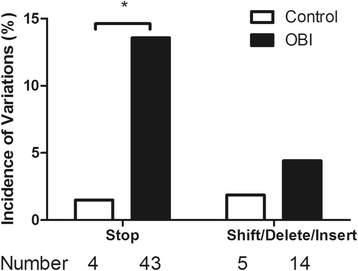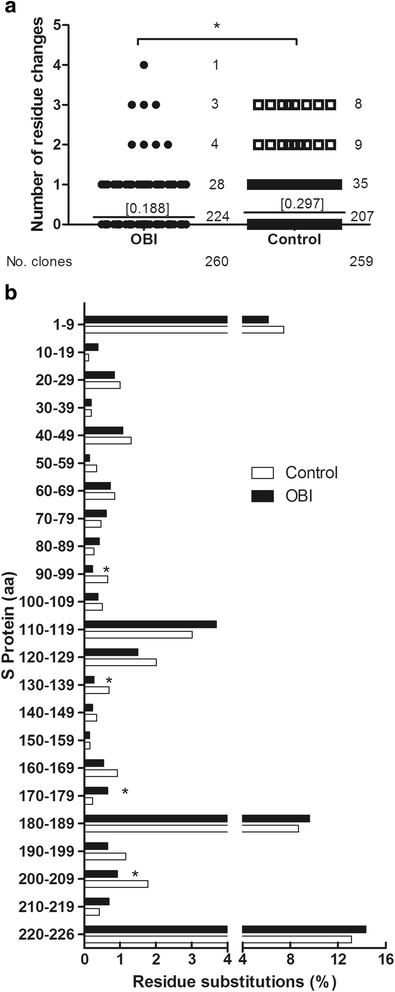Occult hepatitis B virus infection: influence of S protein variants
- PMID: 26786229
- PMCID: PMC4717550
- DOI: 10.1186/s12985-016-0464-z
Occult hepatitis B virus infection: influence of S protein variants
Abstract
Background: In occult hepatitis B viral infection (OBI), the persistence of hepatitis B virus (HBV) DNA is associated with a lack of hepatitis B surface antigen (HBsAg). To assess the possible role of HBsAg immune escape variants in OBI patients, variability in the HBV S gene was evaluated for OBI patients as well as chronic HBV infection patients from the same families.
Methods: We selected 17 HBV DNA-positive/HBsAg-negative patients (OBI group) and 15 HBV DNA- and HBsAg-positive patients from OBI families (control group). The S gene was amplified and cloned, and at least 15 clones per patient were sequenced and analyzed.
Results: Although the incidence of stop codon mutations within the S region was higher in the OBI group (13.6 %) than in the control group (1.5 %, P < 0.001), this type of mutation, together with insertion and deletion mutations, was prevalent in only three OBI patients. In the major hydrophilic region (MHR), a median of 0.75 residues were altered in every 100 residues for the OBI patients, whereas 0.95 out of 100 residues were changed in the control group (P = 0.428). Furthermore, some variants that are generally considered immune escape variants, such as mutations at positions s145, s147, and s123, were only observed in less than 5 % of all the clones sequenced, in either OBI or control group.
Conclusions: Our data suggest that HBsAg variants may not play a major role in OBI pathogenesis.
Figures



Similar articles
-
Frequency of HBsAg variants in occult hepatitis B virus infected patients and detection by ARCHITECT HBsAg quantitative.Front Cell Infect Microbiol. 2024 May 3;14:1368473. doi: 10.3389/fcimb.2024.1368473. eCollection 2024. Front Cell Infect Microbiol. 2024. PMID: 38766475 Free PMC article.
-
Investigation of occult hepatitis B virus infection in anti-hbc positive patients from a liver clinic.PLoS One. 2015 Mar 12;10(3):e0117275. doi: 10.1371/journal.pone.0117275. eCollection 2015. PLoS One. 2015. PMID: 25763579 Free PMC article.
-
Influence of mutations in hepatitis B virus surface protein on viral antigenicity and phenotype in occult HBV strains from blood donors.J Hepatol. 2012 Oct;57(4):720-9. doi: 10.1016/j.jhep.2012.05.009. Epub 2012 May 23. J Hepatol. 2012. PMID: 22634131
-
Genetic variation of occult hepatitis B virus infection.World J Gastroenterol. 2016 Apr 7;22(13):3531-46. doi: 10.3748/wjg.v22.i13.3531. World J Gastroenterol. 2016. PMID: 27053845 Free PMC article. Review.
-
Occult hepatitis B virus infection: detection and significance.Dig Dis. 2010;28(1):116-25. doi: 10.1159/000282074. Epub 2010 May 7. Dig Dis. 2010. PMID: 20460899 Review.
Cited by
-
Occult HBV infection in Chinese blood donors: role of N-glycosylation mutations and amino acid substitutions in S protein transmembrane domains.Emerg Microbes Infect. 2019;8(1):1337-1346. doi: 10.1080/22221751.2019.1663130. Emerg Microbes Infect. 2019. PMID: 31516090 Free PMC article.
-
Occult Hepatitis B Virus Infection and Associated Genotypes among HBsAg-negative Subjects in Burkina Faso.Mediterr J Hematol Infect Dis. 2018 Jan 1;10(1):e2018007. doi: 10.4084/MJHID.2018.007. eCollection 2018. Mediterr J Hematol Infect Dis. 2018. PMID: 29326804 Free PMC article.
-
Molecular investigation of occult hepatitis B virus infection in a reference center in Northern Brazil.Braz J Infect Dis. 2022 May-Jun;26(3):102367. doi: 10.1016/j.bjid.2022.102367. Epub 2022 May 20. Braz J Infect Dis. 2022. PMID: 35598631 Free PMC article.
-
Occult HBV infection status and its impact on surgical outcomes in patients with curative resection for HCV-associated hepatocellular carcinoma.Hepatobiliary Surg Nutr. 2018 Dec;7(6):443-453. doi: 10.21037/hbsn.2018.10.01. Hepatobiliary Surg Nutr. 2018. PMID: 30652089 Free PMC article.
-
Genomic Variability of Hepatitis B Virus Circulating in Brazilian Western Amazon.Viruses. 2022 Sep 22;14(10):2100. doi: 10.3390/v14102100. Viruses. 2022. PMID: 36298655 Free PMC article.
References
-
- Assar S, Arababadi MK, Ahmadabadi BN, Salehi M, Kennedy D. Occult hepatitis B virus (HBV) infection: a global challenge for medicine. Clin Lab. 2012;58:1225–30. - PubMed
Publication types
MeSH terms
Substances
LinkOut - more resources
Full Text Sources
Other Literature Sources
Medical

